

|
[Deliverables and queries] [Presentation] [Homepage] |
State of the art
The so-called 'Nice earthquake' of 1564 is currently studied
by French (BRGM, Orlèans) and Italian (CNR, Milano) partners. The
starting point of the research were the works by Cadiot (1979, 1980), the
results of which summarized by Fig. 1, and some addresses sketched by J.
Lambert at the beginning of the RHISE project.
In 1989 the French team indexed some potential sources at the
National Library (Paris) and searched through the Archives of the
Boûches-du-Rhône, Var and Vaucluse Departments (Lambert, 1989).
The Italian team has indexed potential sources at the State Archives of Torino
and Genova, at some Archives in Liguria and has explored some funds and some
local sources (Grillo and Moroni, 1989).
In 1990 the French team investigated the Department of Alpes-de
Haute-Provence, Arles and Aix-en-Provence (Lambert, 1990). The Italian team
investigated the far-field Italian area; the results of this investigation
have been published (Moroni and Grillo, 1991).
In spite of the great amount of sources investigated, the progress in the
knowledge of the earthquake remained limited. This is the reason why, before
starting investigation in the State Archives of Torino and Genova, the Italian
team decided to review the sources used by the main seismological compilations.
The results of this analysis are presented in this paper.
The investigation performed by J. Vogt throughout several European
depositories has supplied many suggestions and references: some considerations
on the earthquake can be found in Vogt (1991).
In 1991 the French team investigated archives and libraries
of the Departments of Var and Maritime Alps (Lambert, 1991): the preliminary
conclusions from the French side are presented in this volume (Lambert, 1993).
The Italian team started investigating the State Archives of Torino (Moroni,
1991 and this paper), Genova and Ventimiglia (Rivara e Vaccari, 1992); the
results of this investigation are also reported in this volume (Rivara e
Vaccari, 1993). Finally, an investigation at the Vatican Archives has also
been performed (Castelli, 1993).
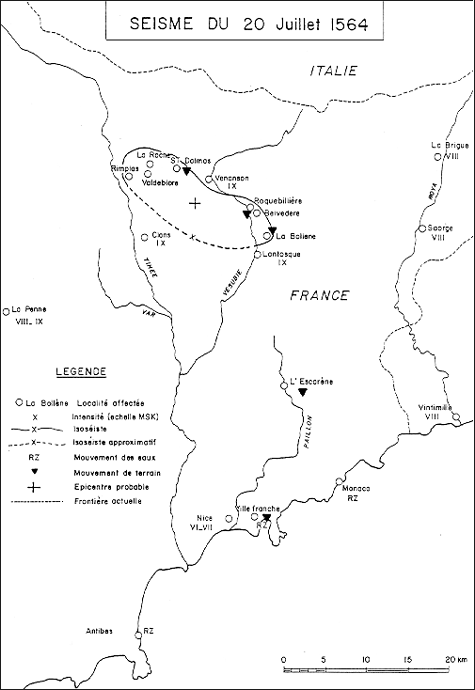
The context
Seismological
The earthquake of 1564 plays a major role in
the assessment of the seismicity of the Maritime Alps. Actually, looking
at the Italian catalogue (Postpischl, 1985), the Nice area seams very active
before the XVIII century, and nearly quiescent later (Fig. 2).
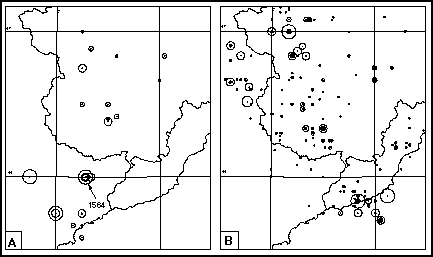
Historical
The area where the 1564 earthquake took place can
be considered a frontier area between two cultural regions, French and Italian.
The Nice area, often called "Les Terres Neuves de Provence" (Fig. 3), was
annexed to the Duchy of Savoy in 1388. The Duchy of Savoy, the territory
of which developed along both sides of the Alps, settled his capital in Turin
only after 1559. The earthquake occurred under Emanuele Filiberto, who tried
to develop the Nice area, the only harbour of the Duchy. The principality
of Oneglia and the county of Tende were officially annexed to the Duchy in
1576 and 1581. After the Napoleonic period, the Nice area, excluding some
limited portions which had been attached to France, was again under the Savoy
Kingdom until 1860. A small portion of territory (including Tende and la
Brigue) was annexed to France only in 1947 (Fig. 3a).
The peculiarity of this area is underlined also by the gap between the political
and ecclesiastical partitions. Actually, the eastern part of the Nissart
area belonged to the diocese of Ventimiglia, which covered also territories
belonging to the Republic of Genova; the western part was shared among the
diocese of Nice and those of Embrun, Glandeve and Vence, which shared also
territories belonging to France (Castelli, 1993).
Further than the Nissart area, the earthquake has presumably
affected :
- the territory of the Principality of Monaco (Fig. 3b), which
was larger in 1564 (Menton and Roquebrune left the Principality in
1848);
- the western part of the Republic of Genova, extinguished in
1797 and later absorbed by the Savoy Kingdom (then Kingdom of Sardinia);
- the southern part of Piemonte (Duchy of Savoy);
- the eastern part of Provence (Kingdom of France).
The complicated history of the area has therefore deeply influenced the
distribution of the sources throughout the depositories and it is to be carefully
taken into account in order to improve the chance of new findings.
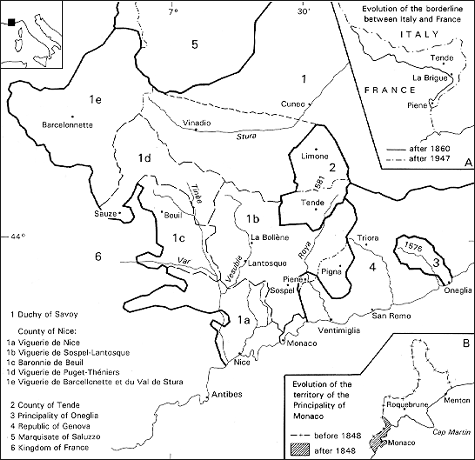
The area where the heaviest damage is supposed to have taken
place (Val Vésubie) had been scarcely populated through centuries.
Tab. 1 proposes some figures of the population in two different times, taken
from a recent paper (Salomone, 1948).
|
|
|
inhabitants rate |
|||
|
|
|
|
|
||
| Rocca Sparviera |
5 |
180 |
- |
- |
|
| Duranus |
- |
- |
46 |
276 |
|
| Utelle |
42 |
1.512 |
410 |
2.460 |
|
| Lantosque |
33 |
1.188 |
317 |
1.902 |
|
| La Bollène |
8 |
288 |
155 |
930 |
|
| Belvédère |
17 |
612 |
220 |
1.320 |
|
| Roquebillière |
12 |
432 |
245 |
1.470 |
|
| S. Martin Vésubie |
35 |
1.260 |
302 |
1.812 |
|
| Venanson |
- |
- |
50 |
300 |
|
The number of inhabitants is estimated from the number of "feux"
and "chefs de maison". The author underlines that the anomalous increase
of the population of Roquebillière and La Bollène from 1614
to the end of XVII century can suggest that the population of the two villages
had anomalously dropped before 1614, may be because of earthquakes.
The earthquake in the seismological literature
As a first step, in order to accomplish a preliminary review,
it has been checked how the main seismological compilations, covering the
area and the time of the earthquake, deals with this event (Tab. 2).
| Breventano, 1576 |
- |
Perrey, 1845 |
|
De Rossi, 1889 |
- |
| Sardo, 1586 |
|
Pilla, 1846 |
- |
Mercalli, 1897 |
|
| Da Secinara, 1652 |
- |
Perrey, 1847 |
- |
Baratta, 1899 |
- |
| Bonito, 1691 |
|
Perrey, 1848 |
|
Baratta, 1901 |
|
| Seyfart, 1756 |
- |
Billiet, 1850 |
- |
Schorn, 1902 |
- |
| Bertrand, 1757 |
- |
Prost, 1855 |
|
Candreia, 1905 |
- |
| De Morani, 1795 |
|
Volger, 1857 |
- |
Milne, 1911 |
|
| Napione, 1808 |
|
Mallet, 1853 |
|
Montandon, 1953 |
|
| Hoff, 1840 |
|
Mercalli, 1883 |
|
Vogt, 1979 |
|
Fig. 4 presents a simplified family-tree of the records of the
1564 earthquake, that is the relationship among the records as they are declared
by the sources of the compilations.
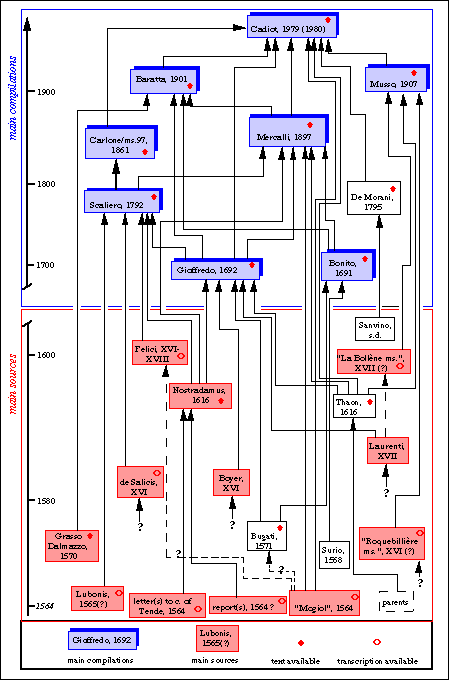
By the term "source" it is simply indicated here every "source
of information", no matter whether it can be considered a proper "historical
source" or simply an historical compilation. This set therefore includes
compilations, such as Gioffredo (1692), Scaliero (1795), which quotes sources
part of which have been found, or such as Nostradamus (1616) and Musso (1907),
the sources of which have not been found. It also includes sources, found
or not, which provide information without quoting any further source.
The main compilations
Only a few main compilations contribute at least one independent,
coeval source. Four of them are seismological, the rest are historical. In
some cases these compilations are the only way to know coeval record, the
sources of which are lost, or not found up to now.
Bonito (1691) reports some parts of his sources, mostly from
Surio (L. Sauer, 1568) - saying that he exaggerates - and from Bugati (1571).
The records are like to come from the "Mogiol set" (1564).
Gioffredo (1692) , nearly
contemporary of Bonito (1691), wrote an history of the Maritime Alps, published
in 1839, making use, for the 1564 earthquake, of a set of sources from the
area of the earthquake itself. Unfortunately, he only summarizes them and
he is not very careful in providing bibliographical quotations, so that some
of his sources (Blancardi, XVII; Laurenti, XVII) have not been found, yet.
He reports that he has seen a map of the earthquake in the Gastaldi
tables. This sentence has puzzled many later authors (Mercalli, 1897;
Baratta, 1904, 1914; Almagià, 1914; Cadiot, 1979,1980) and has never
been proved. A significant part of the present knowledge of this earthquake
still relies on Gioffredo, because later compilers, such as Scaliero, Mercalli
and Cadiot have widely used his records.
Scaliero (1792) is the author
of an history of Nice stored in Municipal Archives of Nice. This manuscript
is divided into three parts: description of the town of Nice; facts about
saints; sequence of bishops and history of Nice. Only Mercalli (1897) explicitly
refers to this source, though he quotes only the title of the third part
(" Dei Vescovi di Nizza, e di Cimella, e delle cose degne di memoria accadute
in esse"). Cadiot (1979, 1980) knows him through a later, partial copy
made by Carlone (1861), quoted as "ms. 97" of the Municipal Library of Nice.
Levret (1988) reproduces a few lines referring correctly to the title of
the manuscript.
The records of the earthquake are found in the third part, II
vol., pp. 209-214. They consist of two parts. In the first one Scaliero (1792)
copies the text of Gioffredo (1692). In the second one he adds new sources,
such as Lubonis (1565?), Felici (s.d.) and de Salicis (XVI), then he copies
a passage of Nostradamus (1616), longer than the one contained
in Carlone/ms. 97 (1861). This
transcription is faithful with respect to a Nostradamus edition of 1624.
At p. 212, in the margin, there is a record which locates the
event on August 1st, 1564 (no sources). Cadiot referred this record to "Anonimo,
s.d.". A record of an earthquake in 1566 (which Cadiot refers also as "Anonimo"),
is reported in the analytical index, but has not been found. This record,
reported by Carlone/ms. 97, could have been written on a flying insert (there
are many inside), which can be lost. At p. 214 there is a record concerning
a landslide in Valdeblore in 1568 (source: de Salicis, XVI).
According to Toselli (1860), Scaliero uses a lot of sources:
compilers, manuscripts and so on. Scaliero does not mention anything about
his sources.
De Morani (1795) is the only compilation
associating Lombardia to this earthquake, but locates it in January 1564.
The source, Sanvino is not known. Investigation has been made in the works
of Francesco Sansovino ("Cronologia del mondo", 1582; "Cronico delle cose
passate", 1591; "Venezia città nobilissima", 1591), but without success
so far .
The so-called ms. 97 (Carlone, 1861) quoted by
Cadiot (1979, 1980) is nothing else but an "extract" (see title) of the Scaliero
manuscript produced by Auguste Carlone in 1861. Some parts of the Scaliero
manuscript have been summarized or omitted. The records of the earthquake
are given at p. 37v - 39r of vol. II. The part concerning Gioffredo is omitted,
while other parts are incomplete: only the Latin text by Lubonis is reported,
the record by Felici contains only the date (20 August); from the text of
Nostradamus, only the letter to the count of Tende is given. The transcription
of de Salicis is faithful with respect to Scaliero.
The record reported by Scaliero at p. 212 (quoted by Cadiot
as "Anonimo, s.d.") is inserted in the text:
Il 1° d'agosto ad un ora di notte si son fatti sentire
così gagliardi scuotimenti si tra e principalmente nella valle di
S. Martino che vi fecero cadere moltissime case con inesplicabile danno di
quei abittanti che quasi tutti ne sono stati consunti e stropii che anzi
in varii di que' borghi non vi è restata viva neppure una persona
(p. 38r).
The record of a 1566 earthquake, lacking in Scaliero, is present,
as well as a record of an earthquake in 1569 at La Bollène:
1566. Per causa del terremoto è caduta rovinosamente
una parte d'un monte in vicinanza di Peglia. 1569. Terremoto seguito nel
luogo della Bollena con innalzamento di polvere e vapori di zolfo quali durarono
per un quarto d'ora col sconquasso di quel paese avendo replicato più
e più volte (p. 39r).
It follows a remark concerning how Gioffredo deals with the
1564 earthquake with respect to the attitude of Emanuele Filiberto.
Mercalli (1897) produced a detailed
study on the earthquake. He knows most of the main sources, including Scaliero,
and he is the first quoting three versions of a German report which later
Almagià and Cadiot assume as the Mogiol's letter. He quotes Hoff as
negative, and reports data from Sanremo (Nota, 1832; Lotti, 1806?) and Porto
Maurizio.
Baratta (1901) follows Mercalli (1897)
and adds the information concerning Piemonte, from Grasso Dalmazzo
(1570).
Musso (1907) is quoted only by Cadiot
(1979, 1980), who deals with the earthquake using three sources: Thaon (1616)
and the two manuscripts of Roquebillière (XVI?) and La Bollène
(XVII?). Musso is the only author quoting these manuscripts, but he does
not say anything about their location. He gives some more information without
reporting the sources:
- the 20th of July 1564 "Syndics" of Roquebillière were
Jean Drago alias Sésac and Jean Fassi;
- the 2nd of November 1564 the duke Emanuele Filiberto went
to survey the damage caused by earthquake (it is to be stressed that Gioffredo,
1692, reports this journey, but says that the duke went to St. Martin to
examine his mines and that in this circumstance he pronounced a sentence
about some controversies between St. Martin and Venanson);
- the governor of Nice - Thomas de Valperga - organized the
rescue (in this case the source used by Musso could be Durante (1832) also
quoted by Mercalli, 1897). According to Baratier (1969), in 1564 the Governor
was Honoré de Grimaldi de Beuil;
- in 1572 the inhabitants of Roquebillière asked Honoré
Lascaris, commandant of the "Viguerie de Sospel", to build up a chapel in
the town square.
The main sources
Some of the sources quoted by the main compilations are of great
importance, either because they are contemporary to the event or (and) because
they provide (so far) unique information.
The "Mogiol set" (1564)
The map and the letter, found at the Erlangen Library in a broadsheet printed
by Hanns Adam (Mogiol, 1564), represent one of the most important, coeval
source for this earthquake, and have served as basic reference for most
historians and seismologists who have dealt with this earthquake. But some
problems are still unsolved.
The map. Two versions of the map
are known. The coloured one (Mogiol, 1564) was published by several authors
(Strauss, 1975; Cadiot, 1980; Deresiewicz, 1982; Kozák and Thompson,
1991); the second one, published and discussed by Almagià (1914),
differs from the first one for some details and, mostly, for the fact that
it contains a scroll in Italian, which summarizes the effects of the earthquake.
Some localities presented as damaged on both maps, such as Rocca Marina,
Sandalingi, Villaret, are not definitely identified; the other four damaged
localities (Morena/La Bollène, Rocca Baliera/Roquebillière,
Roccia/La Roche, Repelle/Rimplas) are heavily mislocated with respect to
the undamaged ones.
The letter. The author is supposed
to be a Genoese merchant, therefore the original text should have been in
Italian, but it has not been found so far. The relationship between map and
text is evident in the content of the text, thought it does not mention the
map explicitly. This fact can support also the hypothesis that text and map
came from different authors and had just been printed together by Hanns Adam.
Some different versions of the letter have been found, but it seems very
difficult to draw conclusions about the filiation of them at this stage.
Tab. 3 presents a comparison among some elements - earthquake date and locality
names - of these versions.
|
Nürnberg, 1564 |
ms. |
Dillingen, 1564 |
Augsburg, 1565 |
Augsburg, 1566 |
|
Erlangen |
Zurich |
Wolfenbüttel |
Wolfenbüttel |
|
|
German |
Latin |
German |
German |
German |
|
|
||||
|
XVII AUGUST MDLXIIII |
18 Augusti 1564 |
17 Augusti |
18 Augusti |
|
|
XX. IULY [1564] |
zwantzigte tag |
20 Julij [1564] |
20. Juli |
|
|
ROCCA MARINA.
REPELLA. |
Roccamanciana.
Regola. |
Rocca Marina,
Reple, |
Rocamarina /
Repella / |
Rocca Marina / |
|
VILLAFRANCA |
Villa Frantiae |
Villa franca |
Villafranca |
Villa Franca |
Lubonis, 1565 (?)
Scaliero (1792, p. 211) reports: "Il Sig.r Nottaro Giò
Lubonis Cittadino di Nizza ha nottato il suddetto Terremoto in un suo Protocollo
à fogli 79 retro del 1564 in idioma latino, qual ho tradotto in lingua
italiana come segue". It follows the translation of the text from Latin
to Italian. Firmly inserted through the pages 211 and 212 there is a Latin
text, written by a different hand:
De admirabili hora et horrendo terremotu in comitatu Niciense
facto.
Anno ipsi millesimo quingentesimo
[quinquagesimo deleted] sexagesimo
quarto indictione septima et die iovis vigesima iulii circa unam horam noctis
fuit quidam terremotus in Comitatu Niciense Ö in loco Saurgi una pars
Castri devastata fuit, Castrum pene dictionis janue devastatum fuit, pars
Castri Vigintimiglie pariter ruinata fuit et quam pluries allii loci devastati
fuerunt et continuavit ipse terremotus per aliquot dies
[....................................]
et terremotus ipse continuavit usque ad festum pentecoste et sic fere
per unum annum
a fol. 79 dicto, del prottocolo di Gio. Lubonis del 1564
(Scaliero, 1792).
Mercalli reports almost entirely the Latin text, omitting a
few sentences, among which the one concerning " indictione septima".
This sentence is also omitted in the Italian text of Scaliero. Actually
"indictione septima" corresponds to the year 1564 (Cappelli, 1978);
further, according to Cappelli (1978), the 20 of July was a Thursday, which
is consistent with " die iovis".
It is also to be stressed that the text, which Scaliero says
found annexed to the 1564 notary protocol (and confirmed by the last line
below the Latin text), mentions that the earthquake continued until Pentecoste
(must be that of 1565), lasting nearly one year. Therefore it doesn't seem
reasonable that it was written in 1564.
The Latin text makes clear that " Castrum pene dictionis
Janue" is the castle of Pena (also La Penna, la Piena, or la Piene),
former stronghold of the Republic of Genova ( [juris] dictionis Janue),
annexed to France in 1947, today Piene Haute (Fig. 3).
No trace of any notary called Lubonis (Lubon) has been found
during a rapid survey (ADN, XV-XIX). The only Lubonis found is a Louis (1815-
1893), which Derlange (1988) said to be descendant " d'une famille fixée
à Nice depuis le XVIe siècle".
Grasso Dalmazzo, 1570
Baratta (1901) quotes in his "Appendice", the edition of this
Cronaca published by Promis (1871). This Cronaca covers the period 1484-1570
and appears as a continuation of the previous Chronicum Cunei (Rebaccini,
1484ca). Grasso Dalmazzo probably was born in S. Dalmazzo (now Borgo S. Dalmazzo)
and there he lived. His Cronaca tells about this village and the near town
of Cuneo.
The Cronaca reports that in the 1564, July 20, an earthquake
was felt " in queste nostre bande del Piemonte"; up to now this is
the only one positive information about Piemonte.
The search for the original manuscript has not obtained positive
results: it seems that the original has been lost. Some copies, written in
XVIII and XIX, are at the Biblioteca Civica of Cuneo, but they don't contain
the sentence about the earthquake. Another copy is in Torino, Biblioteca
Reale. It was made in 1768 by Nallino (1768) and Promis (1871) used it for
his edition.
de Salicis, XVI
Scaliero says that Giovanni Andrea de Salicis was prior of Val
de Blore - priorate at that time dependent on the abbey of S. Dalmazzo di
Pedona, now Borgo S. Dalmazzo, Cuneo - and quotes the parish books which
should have reported the earthquake on May 5, 1564:
Il Prete Giovanni Andrea Salicis Priore della Val di Blora
lasciò scritto ne suoi libri della Parochia esser seguito li 5 maggio
1564 un Terremoto che la scossa durò un quarto d'hora, e che la Parochia
di S. Giacomo in detta Valle annessa alla principal Parocchia di San Dalmazzo
Val di Blora si sobbissò, e resovi morto il Signor Claudio Guigo,
e che i Libri Baptisatorum, e tutti gli altri della Parochia restarono ivi
sepolti, che in seguito di tal sobbissamento fu duopo formar da vicino una
Cappella con assi, ò sii tavole di bosco, ove pendente un anno, e
mezzo si fecero le funzioni Parocchiali, e che il luogo della Rochia quasi
tutto si sobbissò per fatto di detto Terremoto, e restaronvi morte
50 Persone, detto Luogo della Rocchia è luogo mezzano fra S. Dalmazzo,
e la Bolina, benche componenti tra tutti una sol Communità
(Scaliero, 1792).
From this account we know that the " parrocchia" di S.
Giacomo (does it mean parish church or territory?) collapsed and that 50
people died at la Rocchia (la Roche). He precises that la Rocchia is between
" S. Dalmazzo and la Bolina" (la Bolline, not to be confused
with La Bollène), but he does not account for damage
at S. Dalmazzo and la Bolina.
The author also accounts, through Scaliero, that in 1568 the area suffered
from landslides and flooding due to heavy rains.
Il suddetto prete Giovanni Andrea Salicis Prior della Valdiblora
seguita a scrivere ne suoi libri della Parochia che nel 1568 per causa delle
grandi pioge la terra formò delle grandi rovine, tal ché dai
monti di Raja, e Giubiar le acque intorbidite discesero nel Piano, et distrussero
una gran possessione di coltivo terreno, che dice esser esso Terreno il più
bello di quella valle, e che fu causa di grandi dissenzioni fra il popolo
per non poter più riconoscere l'estenzione della loro proprietà
(Scaliero, 1792).
Carlone copied these records from Scaliero without
alterations.
Following the paper "Le prieuré de Valdeblore", published
by Nice Historique in 1953, Giovanni Andrea de Salicis was charged on April
30, 1565, after the previous prior, Ludovic Grimaldi, resigned in 1565.
Boyer, XVI
The records of the earthquake by Pierre Antoine Boyer are known only
through Gioffredo and from him through Scaliero, who copies Gioffredo, and
Mercalli. Gioffredo reports through him that the earthquake lasted about
50 days and that Roquebillière and Belvédère were exempted
from taxes for 10 years.
This source has not been found. Toselli (1860) quotes a manuscript
about the history of Nice in Italian and Latin.
Nostradamus, 1616
The author is Ceasar Nostradamus, the eldest son of the celebrated
Michel (who spent the last part of his life in Salon-de-Provence, where he
received the King Charles on October 17, 1564, and died on July 2, 1566).
The text contains the well known letter to the count of Tende and
a report said to have been left " on a roll written in
nissard by someone from the Nice area who passed at Salon in the same
times" of the event.
Scaliero (1792) transcribes, with some adjustments, the whole
text of both letter and report. After the text, Scaliero adds
a remark: " queste nove furono scritte al suddetto Conte di Tenda dalle
Parti di Terranuova, cioé della valle d'Entraunes, Contado di Boglio,
e Valle della Tinea, di Lantosca, e di Sospello".
Carlone/ms. 97 (1861) transcribes only the letter and the remark,
and summarizes the report as follows: " Scalier continue sa citation
de Cesar Nostradamus et passe à millé contes qui n'ajoutent
rien à tout ce sombre tableau".
Letter. It can be stressed that:
- C. Nostradamus says that certain letters were written
from the area of Terreneuve to the Count of Tende, who was
likely Claude, son of Renée de Savoie, count of Tende. Claude was
Governor of Provence in 1564 (died in 1566); this could explain the reason
why Ceasar de Nostradamus could have access to the letter(s).
- The author of the letter is not reported.
- The date of the letter is reported as XX July. This
appears inconsistent with the fact that the letter itself reports 20 July
as the earthquake date. Nevertheless there is no special evidence to assert,
as Mercalli does, that the solution is an error in the name of the month
and that, therefore, the date should be corrected as XX August.
If we assume that the 20 July is right for the earthquake, the "error"
could be as well in the day of the letter: XXX July, or any day between
XX and XXX, could also fit in.
- The text is given in French, but nothing is known about the
original. As the letter mentions only Nice and Ventimille explicitly, it
would not be unreasonable that it could have been written in Italian, or
"Nissard".
- The explanation that Terranuova means the valley of
Entraunes, County of Boglio (Beuil), and the Valley of Tinea
(Tinée), Lantosca (Lantosque-Vesubie) and Sospello (Sospel)
does not belong to the letter itself: it was added by Scaliero (1792) and,
later, by Carlone/ms. 97 (1861) - and, by the way, incorporated into the
text in the transcription found in Levret (1988). It does not seem to have
any relationship with the location of the damage.
Report. The text introduces the locality of Mage, never quoted
so far by the seismological compilations: "En ce mesme temps passa par
nostre ville de Sallon, un qui se disoit de ces quartiers là,
[......], laissa un roolle en sa langue naturelle et Nissarde qui
est comme un vieil Provençal des villes et chasteaux ruynez: en premier
lieu Roche Begleure, et Mage où estoyent restés morts et
accablés sousles ruynes, liusques au nombre de troie cens et plus,
et trente blessés".
Some parts, mainly those concerning La Bollène, Lantosque
and Venanson, are similar to the account of the "Roquebillière ms",
reported by Musso (1907), so that a common source can be supposed.
|
|
|
|
|
|
|
Nice Ventimille Roche Begleure Mage Beauvers La Boullene Lantosque Venasque Cahours Bregue |
Nice Ventimiglia Roquebillière (?) Belvédère Bollène Lantosque Venanson Saorge La Brigue |
Roquebillière manuscript, XVI (?)
Cadiot uses this title for a "manuscript" which Musso (1907)
states to be " in his hand". The "manuscript" should have been in
Italian, as Musso says that he gives a translation, and reports one term
in Italian (profondata, translated as " totalement
démolie"). Musso did not report and traslate all the "manuscript",
as other passages of Musso (p. 47) seem to indicate.
Blancardi, XVII
Nothing has been found concerning this source quoted by Gioffredo. It
is to be stressed that he is the only one quoting Clans. All posterior authors
(Scaliero, 1792; Carlone, 1861; Mercalli, 1897; Cadiot, 1979, 1980; Levret,
1988) quote him through Gioffredo. From Toselli (1860) we know that a Jean
François Blancardi was born in Sospello in 1572. In this case, the
author was not an eye-witness of the earthquake.
Laurenti, XVII
Gioffredo quotes this manuscript and Scaliero copies him. This source
is the only one quoting Antibes. The text presents similarities with Mogiol
(1564). From Toselli (1860) we know that there was a family Laurenti (Laurent)
from Belvédère, and that Honorè, priest, died in 1612.
Remarks
Tab. 4 shows a comparison among parts of some sources described
above. It can be seen that two of the sources which provide more information,
Nostradamus (1616) and the Roquebillière manuscript (XVI?), show some
similarities: for instance, the number of casualities is pretty the same
and the damage description at La Bollène, Venanson, Lantosque and
Saorge is similar. The Roquebillière manuscript appears then as a
merge of records extracted from both texts reported by C. Nostradamus, with
the insertion of two phrases concerning Valdeblore, which are not exactly
coincident with
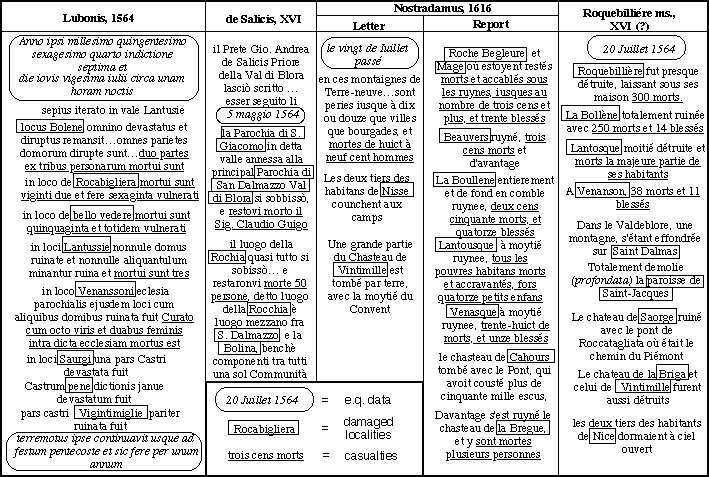
the description given by de Salicis. It could be an extract
of information taken from the known sources (Nostradamus, Salicis), and even
a summary performed by Musso (1907) himself. From the other side, the number
of casualities increases with time from Lubonis to Nostradamus and
Roquebillière manuscript. Tab. 5 summarizes the
effects of the earthquake as reported by the main sources. The table is to
be handled carefully as the timing problems, also shown in the table, are
not yet full solved.
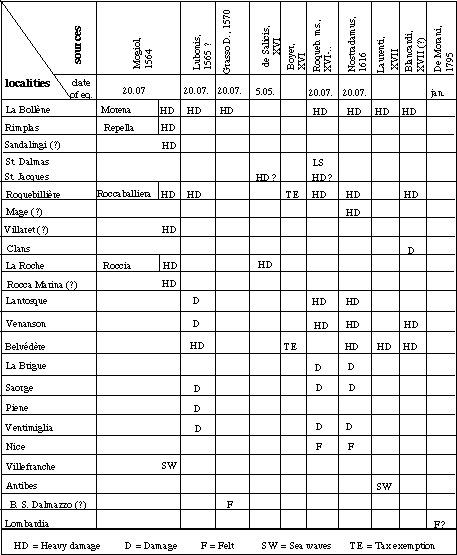
Further investigations
Nice area
At the State Archives of Torino the investigation (Moroni, 1991)
has been devoted to the funds concerning the administration of the county
of Nice (ASTo, 1565-1567; ASTo, XVIa), the correspondence of the Duke of
Savoy (ASTo, 1562-1567), the main officials in duty in the Nissart area (ASTo,
XVIb) and the Savoy laws (Borelli, 1691; Amato et al., 1818-69). These funds
have been carefully investigated for a time window of six months before and
two years after the earthquake date, recording all the subjects they deal
with. Fig. 5 summarizes the results.
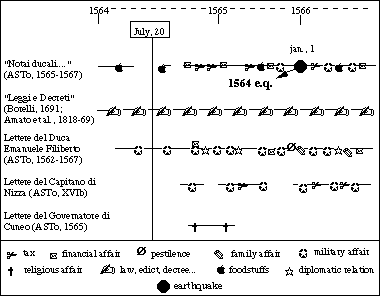
Only one earthquake record has been found, concerning a 20 years
tax exemption, allowed in 1566 by the Duke to the inhabitants of La
Bollène:
1566 primo gennaio
Ö A tutti sia manifesto che havendoci humilmente supplicato
li diletti fedeli nostri huomini della comunità della Bollena nel
contado di Nizza che atteso le ruine et disaggi, da loro patiti per causa
di terremoti che successero l'anno 64 et sempre hanno continuato et ancora
Ö continuano fosse di buon piacer nostro di essimerli et liberarli di
tutti i carichi straordinari tanto reali che personali
[Ö] per il tempo di vinti anni (ASTo,
1565-1567).
It has to be recalled that Boyer (XVI) mentions 10 years tax
exemptions for Roquebillière and Belvédère.
No earthquake records have been found in the other funds
investigated.
Piemonte
The investigation has regarded the Cuneo area about which there
was only the record of Grasso Dalmazzo (1570). Another chronicle (Corvo,
XVII) does not mention the earthquake, while local histories (Maccario, 1889;
Gabotto, 1898; Fresia, 1928) report two other XVI century earthquakes (1502
and 1550), but do not quote the 1564 one. Some research has been performed
at the Archives (ASCn, 1565-1586; ASTo, 1565), but no records of the earthquake
have been found (Fig. 5).
Western Liguria
The investigation performed by Rivara and Vaccari (1993) has
regarded ecclesiastical and civil Archives. The bishop's Archives of Ventimiglia
keep only few XVI century documents. The investigation on civil archives
suggests to exclude the possibility that the damage reported at Ventimiglia
and La Piene could be ascribed to the earthquake.
The seismological compilations provide information for some other localities:
San Remo (Nota, 1832), Taggia (Lotti, 1806?) and Porto Maurizio (Mercalli,
1897), though they come from late compilers who do not quote their sources
(Tab. 6).
|
|
|
|
|
|
| Taggia |
|
|||
| San Remo |
|
|
||
| P.Maurizio |
|
The analysis of some chronicles of XVII century has given
contradictory results. A chronicle of San Remo (Borea, XVII-XIX), written
by different hands and starting in the XVII century, quotes the event, but
it does not mention effects in this town explicitly: "Successe un Gran
Terremoto il quale durò per due mesi, facendosi sentire quasi tutte
le settimane, di modo che le persone per la paura dormivano alla campagna
nei Contorni di Nizza e di Sospello, e in altre parti rovinò alcuna
torre".
This source , however , is not coeval . Another source , nearest to the
earthquake, a chronicle compiled by the friar Calvi (1623) speaks about the
1564 facts on the base of his father's telling. He accounts that in the sixties
of the XVI century there were many invasions of Turkish pirates. One of them
was right on 1564, June 9, that is 41 days before the earthquake. This source
devotes many pages to the Turkish invasion and doesn't mention the earthquake.
For Savona a chronicle (Verzellino, XVII) does not mention the 1564 earthquake,
while it seems to pay attention to similar events before and after it.
Fig. 6 summarizes the results of the investigation on S. Remo and Savona.
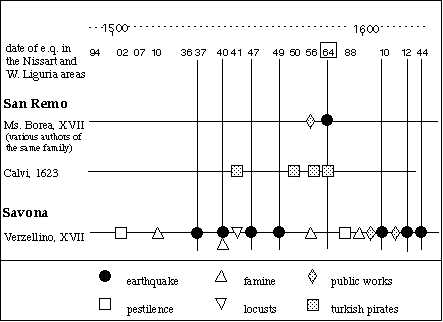
Vatican Archives
The investigation, reported by Castelli (1993), has not provided
earthquake records so far, though some findings cannot be excluded in the
future.
Preliminary conclusions
The investigation of the compilations and other sources leads
to some improvements, though many problems are still open, starting with
timing.
Actually, 1564 seems confirmed as the year of the earthquake
also by the authority of the Duke of Savoy provision (ASTo, 1565-1567). The
date of the earthquake oscillates in the main sources between 20 July and
20 August, though the important records by de Salicis (XVI), reporting May
5, open the door to the possibility that more natural, destroying events
could have taken place in 1564 and have been then cumulated by reporters
and historians. This is also supported by the data coming from Ventimiglia
and Piene (Rivara and Vaccari, 1993), from which it appears that heavy flooding
took place in spring 1564 and was responsible for some damage.
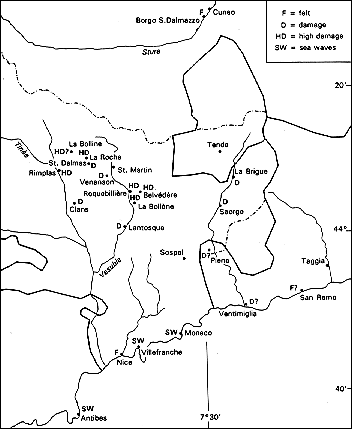
With respect to effects distribution, the main points are:
- heavy damage is reported at Mage, to be located;
- Villaret is still not located: the same holds for Rocca Marina
and Sandalingi. It is to be stressed that S. Martin Vesubie, more important
than Venanson and very close to it, is not mentioned by any source: it can
be suggested that either Sandalingi or Rocca Marina could represent a corruption
of it;
- data referred to la Penne by Cadiot (1979, 1980) should be
ascribed to la Piene, though the previous considerations are to be taken
into account;
- the earthquake was felt in Borgo San Dalmazzo (Cuneo) and/or
the sorrounding areas, but no evidence of damage has been found;
- no records of the earthquake have been found east of Porto
Maurizio. At west, the important record from the Aix chronicle (Lambert,
1993), needs to be carefully located; should it be located at Aix, it could
represent a very important mark far from the epicentral area.
Fig. 7 shows the preliminary effects distribution according
to the data provided by Tab. 5: for the localities covered by several sources,
Mogiol (1564) and Lubonis (1565?), have been preferred. The question mark
at La Bolline indicates a doubt whether the damage should be ascribed to
the locality or just to the church. Question marks at la Piene and Ventimiglia
take into account the previous considerations.
Acknowledgements
The authors wish to thank P. Albini, D. Bellettati, B. Cadiot,
O. Jacquemin, J. Lambert, A. Levret, G. Morelli, B. Resl and J. Vogt for
suggestions or help in retrieving some sources.
Thanks are also due to the staff of the Libraries and Archives
of Nice, Torino and Cuneo.
References
ADN (Archive Departementale de Nice), XV-XIX. Repertoire
Notai, 3.1, 3.2, 3.3, 3.4.
Almagià, R., 1914. Intorno ai primi saggi di carte sismiche. Rivista
Geografica Italiana, XXI: 463-468.
Amato, F., Duboin, C. e Muzio, A., 1818-69. Raccolta delle leggi, editti,
manifesti ecc. emanate dalla Real casa di Savoia sino all'8 dicembre 1798.
Torino, 23 vols.
ASCn (Archivio di Stato di Cuneo), 1565-1568. Ospedale civile S. Croce, Ordinati,
Memoriale degli ordinamenti che si faranno in l'ospitale di Cuneo, vol. III.
ASTo (Archivio di Stato di Torino), 1565-1567. Protocolli notai ducali e
camerali, vol. 226.
ASTo, 1562-1567. Lettere di Principi, Duchi e Sovrani, m. 9: Lettere di Emanuele
Filiberto.
ASTo, 1565. Sezioni Riunite I, Lettere particolari, Lettera R, m. 44: Lettere
di Teodoro Roero, governatore di Cuneo, 26 e 27 aprile 1565.
ASTo, XVIa. Città e contado di Nizza, m. I d'addizione.
ASTo, XVIb. Lettere particolari, Lettera G, m. 50, lettere di Giovanni Amedeo
Valperga di Masino; Lettera V, m. 7: Lettere di Alessandro Grimaldi di Boglio.
Baratier, E., Duby, G. et Hildesheimer, E., 1969. Atlas Historique. Provence,
Comtat Venaissin, Principauté d'Orange, Comté de Nice,
Principauté de Monaco. Paris.
Baratta, M., 1899. Saggio dei materiali per una storia dei fenomeni sismici
avvenuti in Italia raccolti dal Prof. Michele Stefano de Rossi. Bollettino
della Società Geologica Italiana, XVIII: 432-460.
Baratta, M., 1901. I Terremoti d'Italia. Saggio di Storia, Geografia e
Bibliografia Sismica Italiana con 136 sismocartogrammi. Torino, 950 pp.
Baratta, M., 1904. Per la storia della cartografia sismica italiana. Atti
del Congresso Internazionale di Scienze Storiche, Roma, X: 94-95.
Baratta, M., 1914. Ricerche intorno a Giacomo Gastaldi. Rivista Geografica
Italiana, XXI: 135-136.
Bertrand, M.E., 1757. Memoires historiques et physiques sur le tremblements
de terre. La Haye.
Billiet, A., 1850. Mémoire sur les tremblements de terre ressentis
en Savoie. Mémoires de l'Académie Royale de Savoie, Chambery,
XIII: 245-288.
Blancardi, G. F., XVII ?. (unknown title).
Bonito, M., 1691. Terra tremante overo continuatione de' terremoti dalla
Creazione del Mondo fino al tempo presente Ö Napoli.
Borea, XVII-XIX. Manoscritto. N. L. (Editor), 1970. Il manoscritto Borea.
Cronache di Sanremo e della Liguria occidentale. Bordighera, Istituto
Internazionale di Studi Liguri.
Borelli, G.B., 1691. Editti antichi e nuovi de' sovrani Principi della Real
casa di Savoia, delle loro Tutrici, e de' Magistrati di qua da' Monti. Raccolti
d'ordine di Madama Reale Maria Giovanna Battista, per Bartolomeo Zappata
Librario di S.A.R. Torino.
Boyer, P. A., XVI. Storia di Nizza (?).
Breventano, S., 1576. Trattato del terremoto. ms. H 113 Inf., Biblioteca
Ambrosiana, Milano.
Bugati, G., 1571. Historia Universale di M. Gasparo Bugati Milanese nella
quale con ogni candidezza di verità si racconta brevemente, et con
bell'ordine tutto quel ch'è successo dal principio del mondo fino
all'anno MDLXIX. Venezia.
Cadiot, B., 1979. Le séisme nissart de 1564. In: Vogt J. (Editor),
Les tremblements de terre en France, BRGM Mémoire 96, Orléans,
pp. 172-174.
Cadiot, B., 1980. Monographie de quelques séismes anciens (1356, 1428,
1564), Univ. Paris I - Sorbonne, Departement d'Histoire. Mémoire de
Maitrise.
Calvi, 1623. Cronaca. N. Calvini (Editor), 1982. La Cronaca del Calvi. Il
Convento dei PP. Domenicani e la città di Taggia dal 1460 al 1623.
Taggia.
Candreia, J., 1905. Zur Chronik der Erdbeben in Graubünden bis zum Jahre
1879. Bern.
Cappelli, A., 1978. Cronologia, cronografia e calendario perpetuo. Milano.
Carlone, A., 1861. Extrait du manuscript portant pour titre La città
di Nizza insigne per li sacri monumenti. Opera di Giò Pietro Scaliero,
cittadino della medesima, in cui si dà notizia delle antichità
di detta città, Diocesi, Contado, de Santi e delle persone insigni
per la pietà che vi sono nati, morti e sepolti, chiarite con le loro
annotazioni, come pure de' Vescovi e di quelle cose fino a questi giorni
accadute cioé fino alli 29 settembre 1792, Caras. ms. 96-98, 3 vols.,
Biblioteque Municipale, Nice.
Castelli, V., 1993. The Vatican Archives as a 'privileged' observatory on
European eartquakes: some considerations. This volume.
Corvo, G. F., XVII. Cronache di Cuneo, coll'aggiunta di documenti, poesie
e note diverse. ms. 10/1, Biblioteca Civica, Cuneo.
Da Secinara, F., 1652. Trattato universale di tutti i terremoti occorsi,
e noti nel mondo con li casi infausti ed infelici presagiti da tali terremoti
ecc. L'Aquila.
De Morani, G. A., 1795. Notizie cronologiche degli anni che sono stati
molto piovosi, secchi, e freddi all'eccesso e ne quali si sono sentite scosse
di terremoti. ms., Bibl. Acc. delle Scienze, Torino.
De Rossi, M.S. (Editor), 1889. Documenti raccolti dal defunto conte Antonio
Malvasia per la storia dei terremoti e delle eruzioni vulcaniche massime
d'Italia. Memorie della Pontificia Accademia dei Nuovi Lincei, Roma V: 169-289.
de Salicis, G. A., XVI. Libri della Parrocchia di S. Giacomo (?).
Deresiewicz, H., 1982. Some sixteenth century european earthquakes as depicted
in contemporary sources. BSSA, 72: 513-515.
Derlange, M., 1988. Les Niçoise dans l'Histoire. Toulouse.
Durante, L., 1832. Histoire de Nice. Torino.
Felici, C., XVI-XVIII. Calendario (ovvero Effemeride storica) ? (uncertain
title).
Fresia, C., 1928. Cuneo ed Emanuele Filiberto. In: C. Patrucco (Editor),
Lo stato Sabaudo al tempo di Emanuele Filiberto 1553-1575, Torino.
Gabotto, F., 1898. Storia di Cuneo dalle origini ai nostri giorni. Cuneo.
Gioffredo, P., 1692. Storia delle Alpi Marittime. ms., ASTo, Fondo mss.,
H.IV.26.
Grasso Dalmazzo, 1570. Cronaca. D. Promis (Editor), 1871, Miscellanea di
Storia Italiana, XII.
Grillo, P. and Moroni, A., 1989. Revision of the seismicity of Western Alps
with special reference to the 1564 and 1644 earthquakes. CEC Project RHISE,
Progress Report, Milano.
Hoff, K.E.A. von, 1840. Chronik der Erdbeben und Vulcan-Ausbrüche, IV.
Gotha.
Kozak, J. and Thompson, M.C., 1991. Historische Erdbeben in Europa. Zürich.
Lambert, J., 1989. The 1427-1428 Catalan earthquakes and the 1564-1664 Maritim
Alps earthquakes. State of art and first set of research. BRGM, Orléans,
CEC Project RHISE, Progress Report.
Lambert, J., 1990. Project: Review of historical seismicity in Europe.
Révision de séismes majeurs anciens. Partie française
(phase 2). BRGM, Orléans, CEC Project RHISE, Progress Report.
Lambert, J., 1993. The Catalonian (1428) and Alpine (1564, 1644) Earthquakes:
Review of Research in France. This volume.
Laurenti, O., XVII. Delle cose di Bellovedere (?). ms., unknown location.
Levret, A., 1988. Historical seismicity in France and its role in the assessment
of seismic risk on french nuclear sites. In: C. Margottini and L. Serva
(Editors), Proc. IAEA Workshop on Historical Seismicity of Central-Eastern
Mediterranean Region, Roma, 27-29 October 1987, pp. 113-138.
Lotti, V., 1806 ?. Materiali per servire all'Istoria di Taggia raccolti dal
canonico Vincenzo Lotti. ms., Bibliothéque Cessole, Nice.
Lubonis, G. 1565 ?. De admirabili et horrendo terremotu in civitatu niciense
(unknown location).
Maccario, S., 1889. Cronologia storica della città di Cuneo dalla
sua fondazione sino ai dì nostri. Cuneo.
Mallet, R., 1853. Third Report on the facts of Earthquakes Phenomena, Catalogue
of recorded Earthquakes from 1606 B.C. to A.D. 1850. Report of the 22nd Meeting
of the British Association for the Advancement of Science, London, 1-176.
Mercalli, G., 1883. Vulcani e fenomeni vulcanici in Italia. Milano.
Mercalli, G., 1897. I terremoti della Liguria e del Piemonte. Napoli.
Milne, J., 1911. A Catalogue of destructive earthquakes A.D. 7 to A.D. 1899.
British Association for the Advancement of Science, London.
Mogiol, F., 1564. Die Neue Zeytung von den sieben Stetten..., single-leaf
woodcut, Universitäts Bibliothek, Friedrich-Alexander-Universität,
Erlangen.
Montandon, F., 1953. Les tremblements de terre destructeurs en Europe.
Genève.
Moroni, A., 1991. Spoglio di fondi degli archivi di Stato di Torino e Cuneo
e delle Biblioteche di Torino, Cuneo e Saluzzo in relazione al terremoto
del Nizzardo del 1564. In: G. Monachesi e P. Albini, Ricerche di fonti sui
terremoti di interesse del progetto CEE Review of Historical Seismicity in
Europe (RHISE), Macerata.
Moroni, A. and Grillo, P., 1991. Investigating the area of perceptibility:
the case of the 1564, so-called Nice earthquake. In: Kozak, J. (Editor),
Proc. 3rd ESC Workshop on "Historical Earthquakes in Europe", Liblice by
Prague, 4-6 April 1990, pp. 212-223.
Musso, A., 1907. Monographie chronologique de Roquebillière depuis
sa fondation jusqu'en 1907. Paris.
Nallino, P., 1768. Copia della Cronaca di Grasso Dalmazzo (1570). ms. 198,
Biblioteca Reale, Torino.
Napione, G. G., 1808. Ricerche storiche intorno agli antichi terremoti del
Piemonte. Memoires de l'Académie Impériale des sciences,
littérature et beaux-arts de Turin, XIX: 143-159.
Nostradamus, C., 1616. Histoire de Provence. Lyon.
Nota, A., 1832. Del terremoto avvenuto nella città e provincia di
S. Remo l'anno 1831. Pinerolo.
Perrey, A., 1845. Memoire sur les tremblements de terre ressentis en France,
en Belgique et en Hollande. Mémoire couronnés et mémoires
des savants étrangers, Académie Royale de Belgique, XVIII,
Bruxelles.
Perrey, A., 1847. Memoire sur les tremblements de terre dans le bassin du
Rhin. Mémoire couronnés et mémoires des savants
étrangers, Académie Royale de Belgique, XIX, Bruxelles.
Perrey, A., 1848. Memoire sur les tremblements de terre de la peninsule italique.
Mémoire couronnés et mémoires des savants étrangers,
Académie Royale de Belgique, XXII, Bruxelles.
Pilla, L., 1846. Principali tremuoti avvenuti in tempi storici in Toscana.
In: L. Pilla, Istoria del tremuoto che ha devastato i paesi della costa toscana
il 14 agosto 1846, Pisa, pp. 195-217.
Postpischl, D. (Editor), 1985. Catalogo dei terremoti italiani dall'anno
1000 al 1980. Quad. Ric. Scient., 114, 2B, Bologna.
Promis, D. (Editor), 1871. Cronache anteriori al secolo XVII concernenti
la storia di Cuneo e di alcune terre vicine. Miscellanea di Storia Italiana,
XII, Torino.
Prost, O., 1855. Notice sur le tremblement de terre du 29 décembre
1854 comparé à ceux de siécles précédents.
Nice.
Rebaccini, 1484ca. Chronicum Cunei libri tres. Ex codice apographo chartaceo
saeculi XV. In: D. Promis (Editor), 1871, Miscellanea di Storia Italiana,
XII.
Rivara, P. e Vaccari, E., 1992. Stato delle ricerche sul terremoto del
20 luglio 1564 in Liguria occidentale. CEC Project RHISE, Progress Report,
Genova.
Rivara, P. e Vaccari, E., 1993. Ricerca di documentazione d'archivio
sul terremoto del 20 luglio in Liguria occidentale. This volume.
Roquebillière manuscript, XVI (?). unknown location.
Salomone, J., 1948. La Vallée de la Vesubie. ms. 293,
Bibliothèque Municipale, Nice, ms. 293.
Sardo, A., 1586. Discorsi. Venezia.
Scaliero, J., 1792. La città di Nizza insigne per li sacri monumenti.
ms., 3 vols., Archive Municipale, Nice.
Schorn, J., 1902. Die Erdbeben von Tirol und Voralberg. Zeitschrift des
Ferdinandeums, Innsbruck, III, 46: 99-282.
Seyfart, J. F., 1756. Allgemeine Geschichte der Erdbeben. Frankfurt und
Leipzig.
Strauss, W. L., 1975. The German single-leaf woodcut 1500-1600. New
York.
Surio [Sauer], L., 1568. Commentarius brevis rerum in orbe gestarum ab
anno salutis M.D. usque in annum M.D.LXVIII ex optimis quibusque. Coloniae,
Apud Geruuinum Calenium, et heredes Iohannis Quentel.
Thaon,L., 1616. De terræmotu, ejus causis, et syntomatis
philosophicæ et historicæ. Burdigalæ.
Toselli, J.B., 1860. Biographie niçoise ancienne et moderne ou
dictionnaire historique de tous les hommes qui se sont fait remarquer par
leurs actions, leurs écrits, leurs talents, leurs mérites et
leurs erreurs dans la ville et le comté de Nice. 2 vols., Nice.
Verzellino, C.V., XVII. Delle memorie particolari e specialmente degli
uomini illustri della città di Savona, A. Astengo (Editor), 1885,
Savona.
Vogt, J. (Editor), 1979. Les tremblements de terre en France. BRGM
Mémoire 96, Orléans.
Vogt, J., 1991. Le "complexe" de la crise sismique nissarde de 1564.
Quaternaire, in press.
Volger, O., 1857. Untersuchungen über das Phänomen der Erdbeben
in der Schweiz. Gotha.
[Top]
[Vol.1]
[Vol.2]
[Deliverables and queries]
[Presentation]
[Homepage]